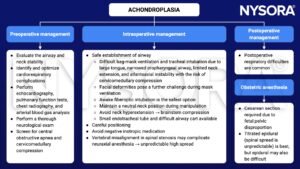Learning objectives
- Describe achondroplasia
- Understand the anatomical features associated with achondroplasia
- Anesthetic management of a patient with achondroplasia
Definition and mechanisms
- Achondroplasia is a bone growth disorder resulting in disproportionate dwarfism
- Genetic disorder of skeletal dysplasia → spontaneous fibroblast growth factor receptor 3 gene (FGFR3) mutation
- Inhibition of cartilage formation, resulting in premature ossification in the epiphyseal growth plates with concurrent restriction of growth → patients fail to achieve a height of 148 cm by adulthood
Signs and symptoms
Facial deformities
- Macrocephaly with prominent forehead frontal bossing
- Macroglossia
- Short maxilla
- Large mandible
- Midfacial hypoplasia with flattened nasal bridge
- Small mouth
Extremity deformities
- Long-bone shortening of proximal upper and lower extremities
- Short fingers and toes with “trident hands” (short hands with stubby fingers and a separation between the middle and ring fingers)
Airway deformities
- Narrowed nasal passages from mucopolysaccharide deposition
- Tracheal narrowing
- Sternal prominence
- Rib hypoplasia
- Pharyngeal and maxillary hypoplasia
- Thickening of pharyngeal and laryngeal structures
- Tonsillar hyperplasia
Spinal deformities
- Short neck
- Cervical spine instability (odontoid hypoplasia)
- Possible atlantoaxial instability
- Spinal kyphosis or lordosis
- Thoracolumbar kyphosis
- Pelvic narrowing
- Spinal stenosis → can result in cauda equina syndrome, nerve root compression, thoracolumbar spinal cord compression, or high cervical cord compression secondary to stenosis of the foramen magnum (rarely)
Other
- Varus or valgus deformities
- Hypotonia
- Hypersalivation
Complications
- Obstructive sleep apnea
- Obesity
- Spinal stenosis
- Ear infections
- Hyperlordosis
- Back pain
- Hydrocephalus
- Severe scoliosis and rib cage deformities may result in restrictive lung diseases, pulmonary hypertension, cor pulmonale, and cardiovascular disease
Management

Keep in mind
- Anesthetic challenges in patients with achondroplasia include potentially difficult airways, often complicated by sleep apnea due to obesity, altered respiratory mechanics, and difficult neuraxial access with the unpredictable spread of local anesthetics
Suggested reading
- Kim JH, Woodruff BC, Girshin M. Anesthetic Considerations in Patients With Achondroplasia. Cureus. 2021;13(6):e15832. Published 2021 Jun 22.
- Spiegel JE, Hellman M. Achondroplasia: Implications and Management Strategies in Anesthesia. December 23, 2015. Accessed January 24, 2023. https://anesthesiaexperts.com/uncategorized/achondroplasia-implications-management-strategies-anesthesia/.
We would love to hear from you. If you should detect any errors, email us customerservice@nysora.com

